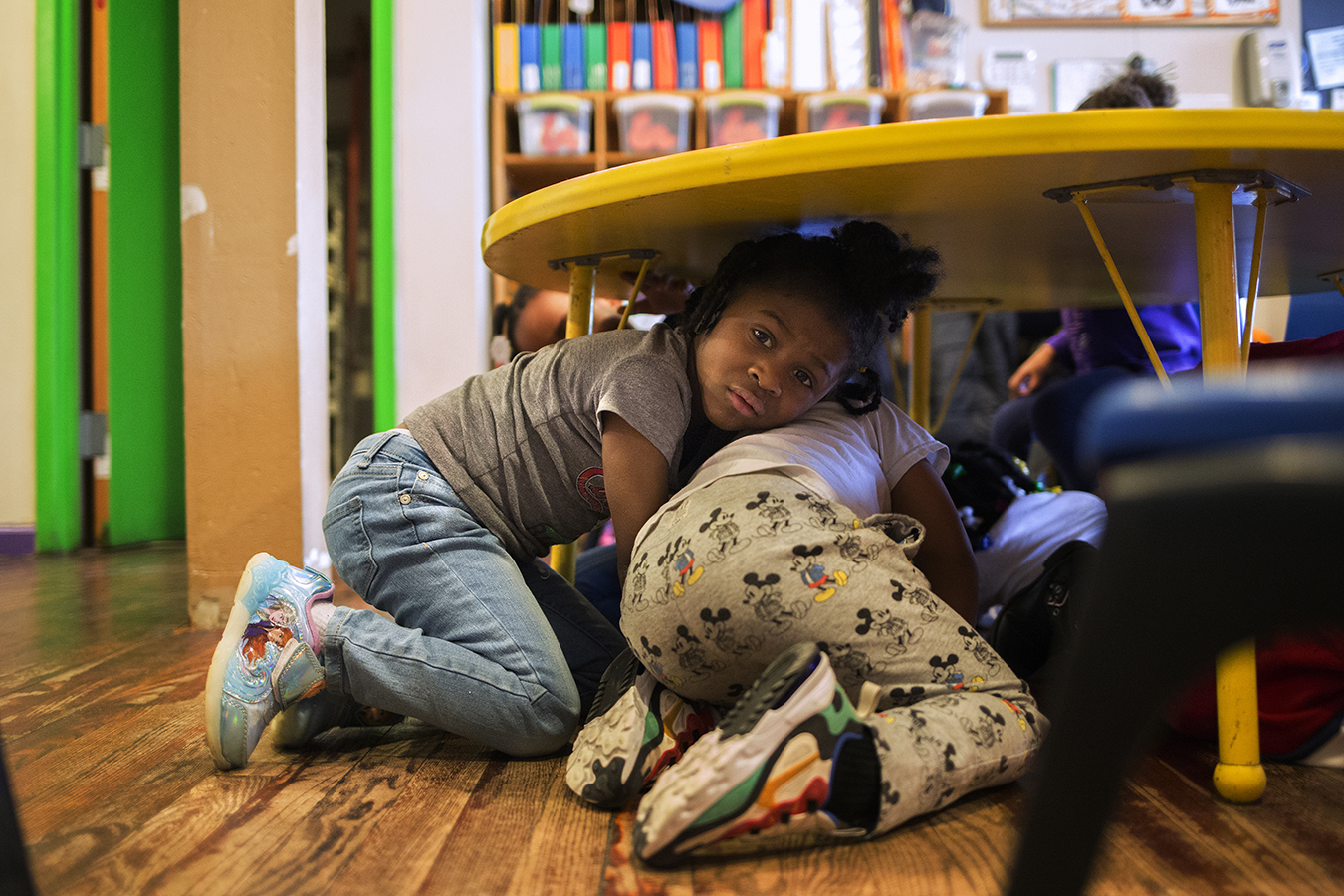
Justice Buress, 4, demonstrates how she hides under a table during a drill at Little Explorers Learning Center in St. Louis. Day care director Tess Trice carries out monthly drills to train the children to get on the floor when they hear gunfire.(Carolina Hidalgo/St. Louis Public Radio)
ST. LOUIS — Champale Greene-Anderson keeps the volume up on her television when she watches 5-year-old granddaughter Amor Robinson while the girl’s mom is at work.
“So we won’t hear the gunshots,” Greene-Anderson said. “I have little bitty grandbabies, and I don’t want them to be afraid to be here.”
As a preschooler, Amor already knows and fears the sounds that occurred with regularity in their neighborhood before the pandemic — and continue even now as the rest of the world has slowed down.
“I don’t like the pop, pop noises,” Amor explained, swinging the beads in her hair. “I can’t hear my tablet when I watch something.”
And when the television or her hot-pink headphones and matching tablet can’t mask the noise of a shooting? “She usually stops everything,” said her mother, Satin White. “Sometimes she cries, sometimes she covers her ears.”
Her grandmother has even watched Amor hide inside a narrow gap between the couch and recliner.
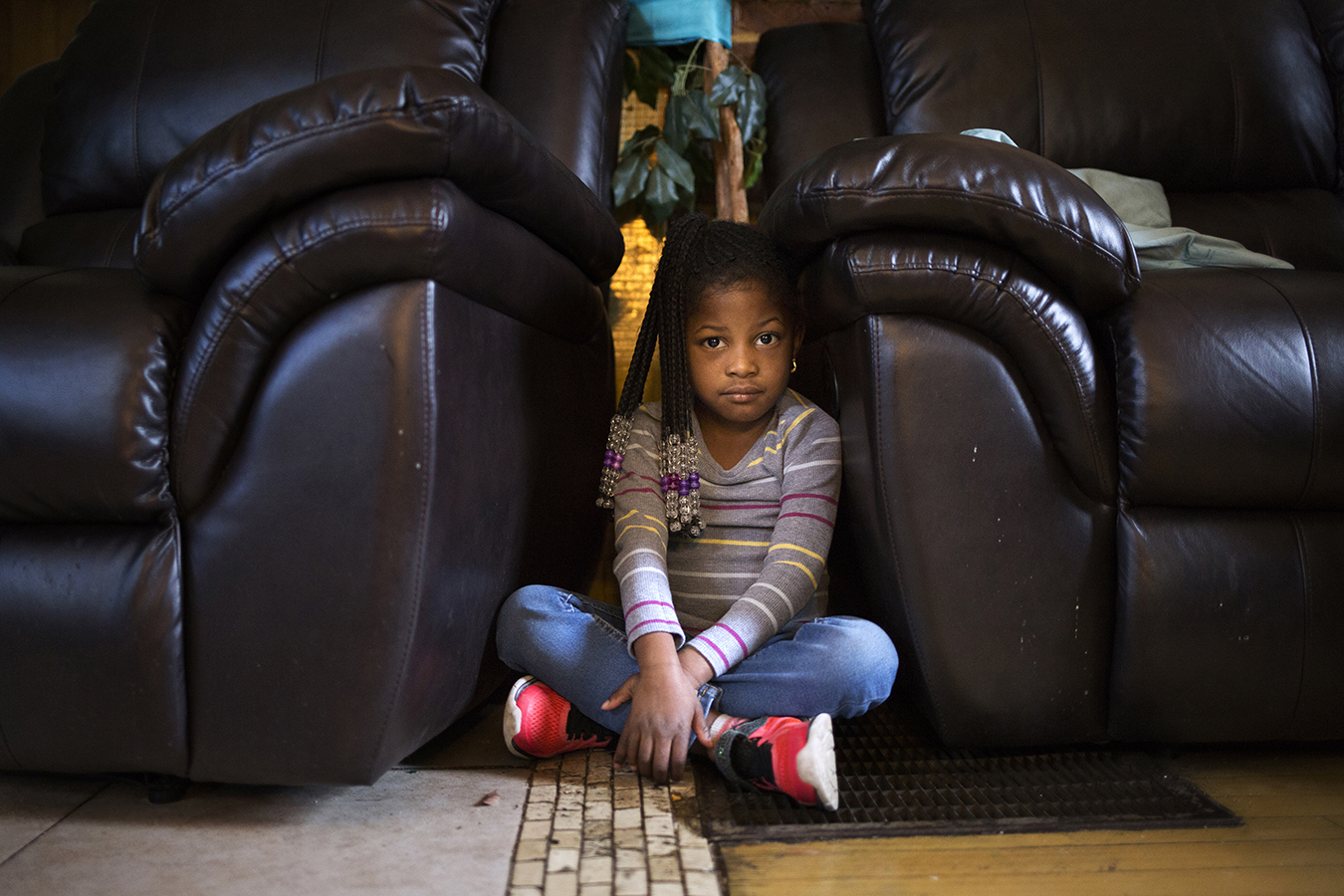
Five-year-old Amor Robinson demonstrates where she sat in her grandmother’s home in St. Louis when she heard gunfire outside. The narrow gap between the couch and armchair recliner became her hideaway.(Carolina Hidalgo/St. Louis Public Radio)
In communities across the United States this spring, families are dealing with more than just the threat of the coronavirus outside their homes. In the midst of violence that does not stop even during a pandemic, children like Amor continually search for safety, peace and a quiet place. “Safer at Home” slogans don’t guarantee safety for them.
More than two dozen parents and caregivers who spoke with Kaiser Health News attested that the kids hide underneath beds, in basements and dry bathtubs, waiting for gunfire to stop while their parents pray that a bullet never finds them.
In St. Louis, which has the nation’s highest murder rate among cities with at least 100,000 people, the reasons are especially stark. More than 20 children in the St. Louis area were killed by gunfire last year, and this year at least 11 children have died already.
While some of the children’s deaths were caused by accidental shootings inside a home, regular gunfire outside is a hurtful reminder that adults have to find ways to keep children safe. And while parents hope their kids grow into healthy adults, evidence shows that children who grow up around violence or witness it frequently are more likely to have health problems later in life.
Can you imagine as a child, you are sleeping, you know, no care in the world as you sleep and being jarred out of your sleep to get under the bed and hide?
Although the mental health of children around the world has been taxed these past few months, for some children the stress has been going on far longer. Regularly hearing shootings is one example of what’s called an “adverse childhood experience.” Americans who have adverse childhood experiences that remain unaddressed are more likely to suffer heart disease, cancer, chronic respiratory diseases and stroke, according to a 2019 Centers for Disease Control and Prevention report.
St. Louis mental health counselor Lekesha Davis said children and their parents can become desensitized to the violence around them — where even one’s home doesn’t feel safe. And, research shows, black parents and children in the U.S., especially, often cannot get the mental health treatment they may need because of bias or lack of cultural understanding from providers.
“Can you imagine as a child, you are sleeping, you know, no care in the world as you sleep and being jarred out of your sleep to get under the bed and hide?” Davis asked.
“We have to look at this, not just, you know, emotionally, but what does that do to our body?” she added. “Our brain is impacted by this fight-or-flight response. That’s supposed to happen in rare instances, but when you’re having them happen every single day, you’re having these chemicals released in the brain on a daily basis. How does that affect you as you get older?”
But future health problems are hard to think about when you’re trying to survive.
At This Day Care, ‘Dora’ Means Drop
The children at Little Explorers Learning Center are getting reacquainted with their daily routine now that the day care facility has reopened for families of essential workers as the COVID pandemic stay-at-home orders loosen. And there’s a lot to remember.
Teachers at the center remind the children of their hand-washing, mealtime and academic routines. They also make sure the kids remember what to do when gunfire erupts nearby. Assistant director Tawanda Brand runs a gunfire safety drill once a month. First, she tells the children to get ready. Then, she shouts: “Dora the Explorer!”
“Dora” is a code word, Brand explained, signaling the kids to drop to the floor — the safest place — in case gunfire erupts nearby.
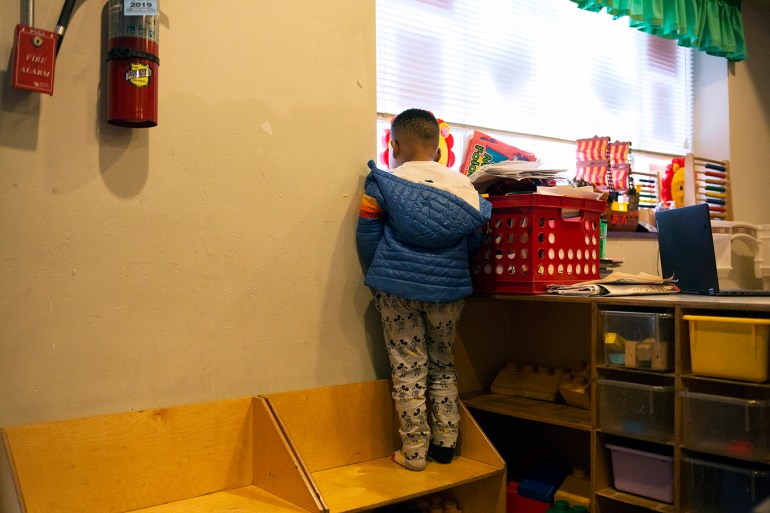
A child looks out the window to watch snow falling at the Little Explorers Learning Center on Jan. 29, in St. Louis. In November 2019, a stray bullet came through the window.(Carolina Hidalgo/St. Louis Public Radio)
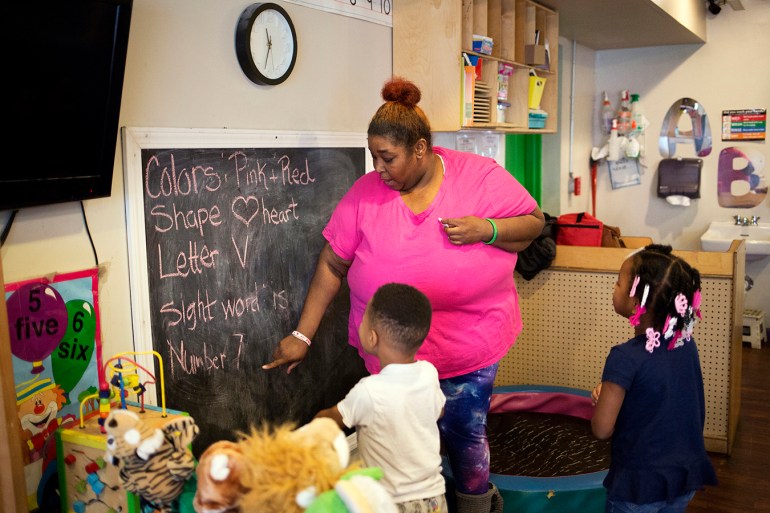
Little Explorers Learning Center assistant director and teacher Tawanda Brand works with preschool students in St. Louis on Jan. 29. After closing temporarily because of the coronavirus, the center reopened in May for the children of essential workers. All staff members now wear masks.(Carolina Hidalgo/St. Louis Public Radio)
During a drill one morning before the pandemic, most of the children got down. Others walked around, sending Brand on a chase as she tried to corral the group of 3- to 5-year-olds.
The drill may sound playful, but sometimes the danger is real.
The Little Explorers protocol isn’t like the “active shooter” drills that took place in schools around the country on the rare chance someone would come inside to shoot — as at Columbine, Parkland or Sandy Hook. The day care program performs these drills because nearby shootings are an ongoing threat.
Day care director Tess Trice said a bullet pierced the window in November while the children were inside. Then, the very next day, bullets flew again.
“We heard gunshots, we got on the floor,” Trice said. “Eventually, when we got up and looked out the window, we saw a body out there.”
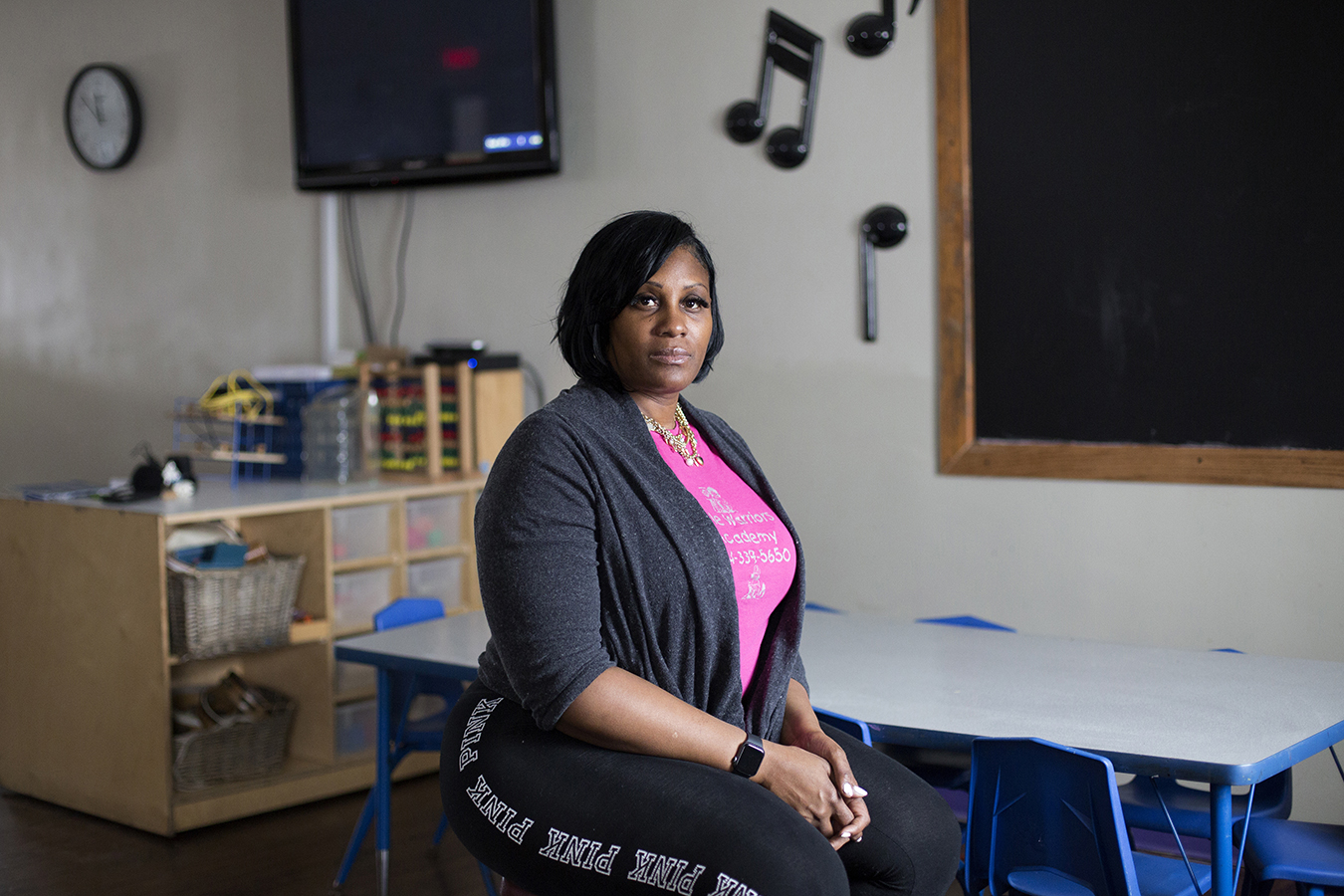
Tess Trice, who owns and runs Little Explorers Learning Center, conducts monthly drills to keep the kids safe amid gunfire, which has come frighteningly close. Trice was photographed on Jan. 29, before the center temporarily closed; it reopened in early May for the children of essential workers, and all staff members now wear masks.(Carolina Hidalgo/St. Louis Public Radio)
Trice called parents that day to see if they wanted to pick up their children early. Nicollette Mayo was one of the parents who received a call from the teachers. She knows the neighborhood faces challenges, but can’t see her 4-year-old daughter, Justice, and infant son, Marquis, going anywhere else.
“I trust them,” Mayo said. “And I know that, God forbid, if there is an incident that I’m going to be contacted immediately. They’re gonna do what they need to do to keep my children safe.”
Trice considered bulletproof glass for the day care center but could not afford it. A local company estimated it would cost $8,000 to $10,000 per window. So she relies on the “Dora” drills and newly installed cameras.
Still, in a city with such an alarming homicide rate, such drills aren’t happening only at the few day care facilities that have reopened. They also happen at home.
‘You Live Better If You Sit On The Floor’
Long before the coronavirus pandemic pushed the world to isolate at home, the Hicks family had their own version of sheltering in place. But it was from gun violence. When they hear gunshots outside their home in East St. Louis, Illinois, everyone hides in the dark.
The goal is to keep the family out of sight, because bearing witness to a shooting could put them at a different kind of risk, mom Kianna Hicks said.
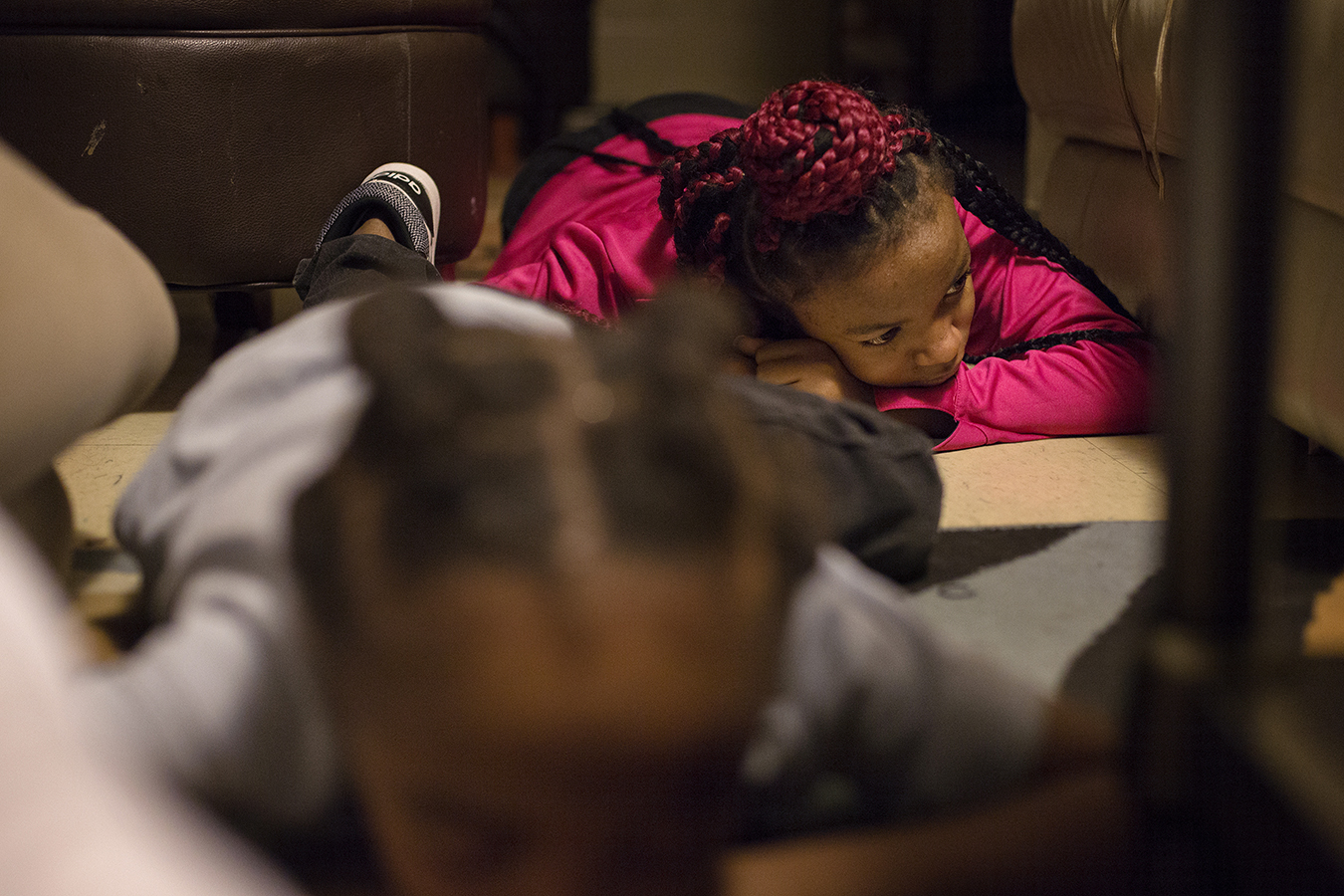
Khanyla Blueford, 12, and her siblings demonstrate a drill they practice in which they drop to the floor quickly at their home in East St. Louis, Illinois. The drill helps them feel prepared for when they hear gunfire, which in past years happened at least twice a week in warm months.(Carolina Hidalgo/St. Louis Public Radio)
So when trouble erupts, they do their best to remain unseen and unheard.
“We turn the TV down,” said 13-year-old Anajah Hicks, the oldest of four. “We turn the lights off, and we hurry up and get down on the ground.”
A few times each month, the family practices what to do when they hear gunshots. Hicks tells the kids to get ready. Then, their grandmother Gloria Hicks claps her hands to simulate the sound of gunfire.
“I need them to know exactly what to do, because in too many instances, where we’ve been sitting around, and gunshots, you know, people start shooting, and they’ll just be up walking around or trying to run,” Kianna Hicks said. “I’ll tell ’em, ‘Naw, that’s not what you do. You hear gunshots, you hear gunshots. No matter where you at, you stop — you get on the ground and you wait until it’s over with and then you move around.’”
And this summer, Hicks wants to make sure the kids are ready. At least twice a week in past years when the weather warmed up, the family got on the floor in response to real gunfire. Violence spikes in summer months, according to the Giffords Law Center to Prevent Gun Violence. And she knows they could be spending more time in the house if football camp for her boys is canceled because of coronavirus fears.
Other families in tough neighborhoods sit on the floor more often, even amid moments of relative quiet. The first time Gloria Hicks saw a family sitting on the floor, she was visiting her godson in Chicago decades ago. It was hot that summer, Hicks recalled, so families kept their apartment doors open to stay cool.
“They were sitting on the floor watching TV and I wondered, Why is it like that?” Hicks recalled. “Then I learned that you live better if you sit on the floor than on the couch, because you don’t know when the bullets gon’ fly.”
‘I Immediately Dropped To The Floor’
Although 16-year-old Mariah knows what to do when bullets fly, she said, she still has a difficult time processing the sound of violence. The honor student was babysitting her little cousins at her St. Louis home last winter when she heard gunshots.
“It couldn’t have been no further than, like, my doorstep,” recalled Mariah, whose mother asked that the teen’s last name not be printed so the discussion of the trauma doesn’t follow her into adulthood. “I immediately dropped to the floor, and then in a split second the second thing that ran through my head is like, ‘Oh, my God, the kids.’”
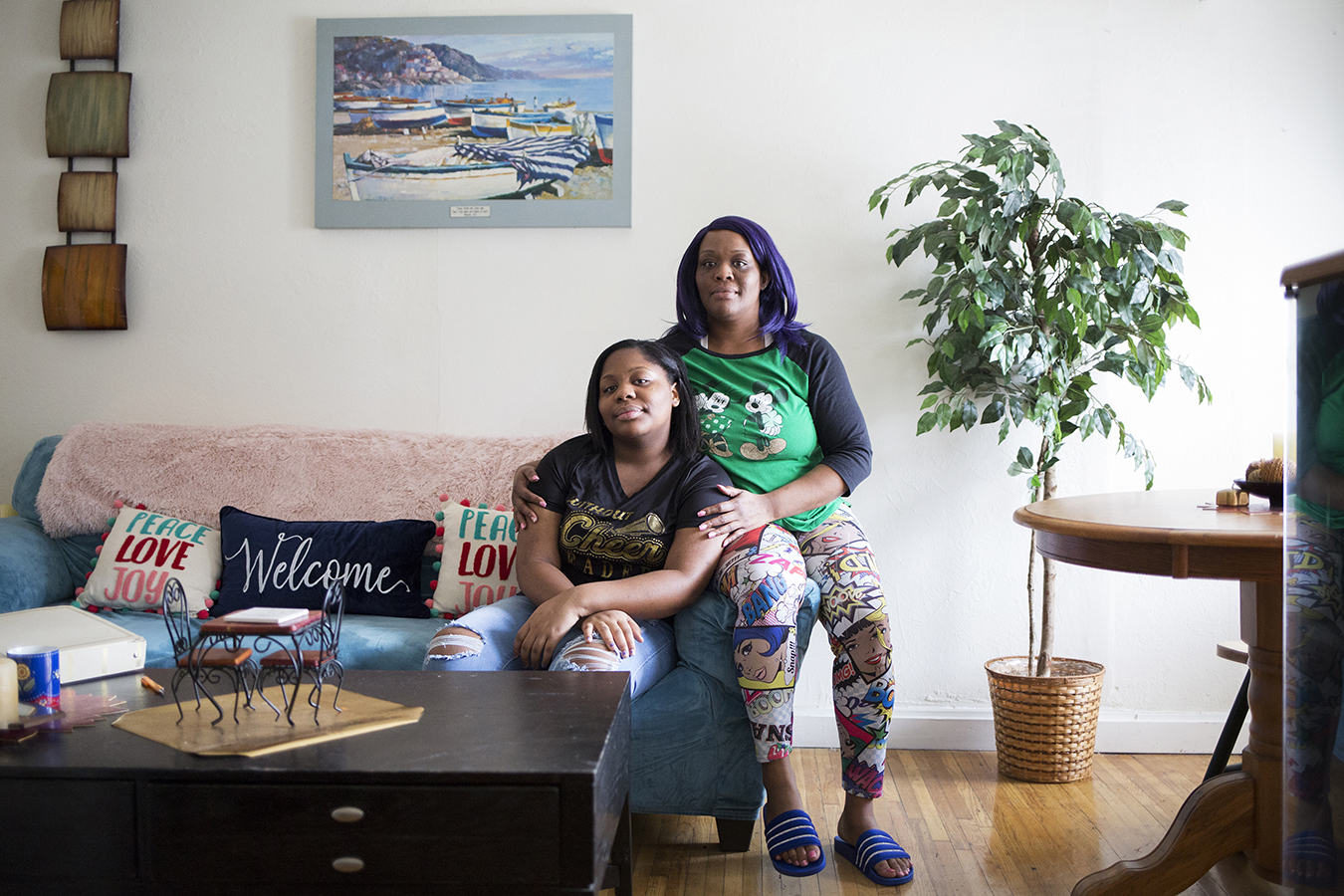
Mariah and her mom, Eisha Taylor, pose for a portrait at their home in St. Louis on Feb. 1. Mariah was babysitting her little cousins there last winter when she heard nearby gunshots.(Carolina Hidalgo/St. Louis Public Radio)
When Mariah walked into the next room, she saw her two younger cousins on the floor doing exactly what their mother had taught them to do when gunfire erupts.
Get down and don’t move.
“I was so worried,” Mariah recalled. “They’re 6 and 3. Imagine that.”
The three kids walked away physically OK that day. But later that night, Mariah said, she pulled out strands of her hair, a behavior associated with stress.
“Pulling my hair got really bad,” she said. “I had to oil my hair again because when I oil it, it makes it hard to pull out.”
Davis, the mental health counselor who has worked for 20 years with children experiencing trauma, encourages parents to comfort their kids after a traumatic event and for the kids to fully explore and discuss their emotions, even months after the fact.
She said getting on the floor explains only how families are maintaining their physical safety.
“But no one’s addressing the emotional and the mental toll that this takes on individuals,” said Davis, vice president of the Hopewell Center, one of the few mental health agencies for kids in the city of St. Louis.
“We get children that were playing in their backyard and they witnessed someone being shot right in front of them,” Davis said. “These are the daily experiences of our children. And that’s not normal.”
Carolina Hidalgo contributed to this report as a journalist at St. Louis Public Radio.






